Two Crossovers in One: Electric- and Gasoline-Powered
Editor/wife Lynne’s day job is a 24-mile round trip drive on city streets. Even though the 2019 Mitsubihi Outlander PHEV’s (plug-in hybrid) electric-only driving range is rated at 22 miles, four of five days she made the round trip emissions free. On the fifth day she ran a few errands after work without having to recharge the battery when the electrons were depleted. That’s because when the battery ran out of juice, a 2.0-liter gasoline engine seamlessly took over to power the compact crossover SUV.
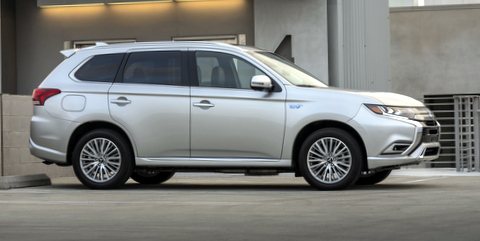
That’s the beauty of a PHEV—electric-only driving without “range anxiety” since a gas engine is there to fill in when the battery is depleted. From there you can either continue driving until the gas tank needs a fill up or, you can recharge the battery.
After nearly five years of on again, off again, Mitsubishi brought its technology flagship, the Outlander PHEV, to the United States in early 2018. The vehicle itself might look somewhat dated, but the technology under the sheet metal is most definitely not. As a testament to how far ahead of its time the Outlander PHEV was a half-decade ago, it remains the plug-in SUV with the longest electric range, the only plug-in hybrid from a non-luxury brand with all-wheel drive, and the only plug-in-hybrid model of any kind to offer Level 3 DC fast-charging.
Since its arrival last year, American car buyers haven’t been as enthusiastic about the 2019 Mitsubishi Outlander PHEV as they are in Europe, where Mitsubishi has sold more than 100,000 units. Plus, over the past three years it has been the top-selling plug-in-hybrid in that market.
A Brief Look at the Powertrain
Unlike Europe, where the 2019 model recieves an all-new powertain, the U.S. version of the 2019 Outlander PHEV’s system carries over from last year. Two large 80-horsepower electric motors—the one at the front wheels produces 101 pounds-feet (lb.-ft.) of torque, and the one at the rear produces 144 lb.-ft.—lay the groundwork for an effective all-wheel-drive system. A 2.0-liter inline-four gasoline engine making 117 horsepower and 137 lb.-ft. is mostly employed to power a big 70-kilowatt generator that feeds power to the main battery and the motors.
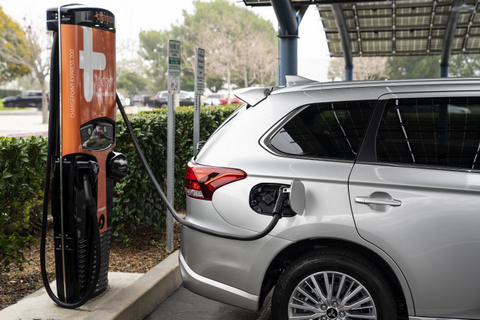
That’s not quite all: Mainly at higher cruising speeds, if it makes sense for efficiency, a hydraulic clutch will also engage the engine while working one or both of the electric motors. The two propulsion motors also double up for regenerative braking.
With or without a charge, you can select a four-wheel drive lock mode that keeps torque flowing to both the front and rear wheels at modest speeds, whereas the rest of the time the system prioritizes whatever is more efficient.
All Outlander plug-in hybrid vehicles have a 12.0 kilowatt-hour lithium-ion battery and charging ports for 120, 240 or 440 volts. While the Outlander’s smaller batteries reduce its cruising range, they also reduce charging time. It takes 3.5 hours to fully charge the batteries with a 240-volt connection. It can get an 80 percent charge in 25 minutes from one of the less-common DC fast chargers. A full charge from a residential 120-volt outlet takes eight hours.
According to EPA estimates, the Outlander PHEV will get 25 mpg in gasoline-only mode and 22 miles of electric driving for a combined 74 MPGe (miles per gallon equivalent). But with a relatively small 11.3-gallon gas tank to make room for the batteries, overall range is only a little over 300 miles.
A Nip Here, A Tuck There
Mitsubishi isn’t giving the 2019 Outlander PHEV a very in-depth visual makeover, but rather a simple yet effective set of changes that keep the three-row crossover from looking stale.
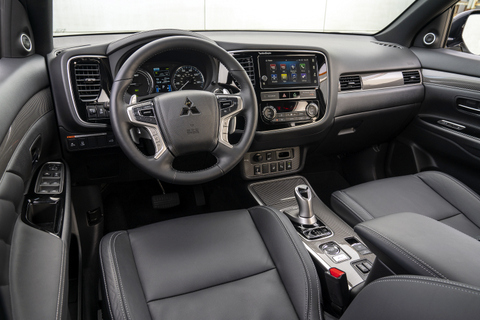
The front receives most of the updates, with the grill taking on a slightly different shape—a bolder “skid plate” along the front bumper’s lower edge, headlights going LED and fog lights getting new rectangular bezels that connect to the vertical accents under the headlights. New 18-inch alloy wheels with a “more elaborate two-tone” design are the only changes to the Outlander PHEV’s sides. Around back, the rear spoiler over the tailgate is now larger, likely for aerodynamic reasons.
Inside, the 2019 Outlander PHEV now has higher quality leather seating, redesigned front buckets with thicker bolsters, reworked buttons on the dash, a new gauge cluster, new trim panels, and new HVAC vents for the rear passengers.
The plug-in hybrid is only available in the Outlander’s highest SEL and GT trims, so the five-passenger SUV comes pretty well-equipped. In addition to leather upholstery and heated front seats, the PHEV features a 7.0-inch touchscreen with Apple CarPlay and Android Auto. The SEL also features a six-speaker stereo with HD and satellite radio. Standard safety features include blind-spot monitoring, rear cross-traffic alert and rain-sensing wipers.
A step up to the GT adds keyless access with push-button start, a power liftgate, sunroof, a heated steering wheel, 360-degree camera, a nine-speaker Rockford Fosgate sound system along with safety features like collision-mitigation braking, adaptive cruise control, lane-departure warning and automatic high-beams.
A standout feature is the 1500-watt AC power supply with two outlets—enough to use small workshop tools such as a drill or to bring the blender along for mid-road-trip smoothies.
On the Road
After driving the 2019 Mitsubishi Outlander PHEV for a week, Lynne and I compared notes and concluded that it was a crossover that we would both like to own. The 22-mile electric driving range was perfect for her roundtrip commute. For me, it was ease of highway driving and the quiet ride, either electric or gas powered. Plus, I liked that I could drive using the gas engine while saving use of the battery until I reached city streets.

Lynne commented that the Outlander was almost unnervingly quiet when driving in EV mode. There was nearly no road noise trundling along surface streets at up to 45 miles per hour. Potholes and bumps in the road were noticed, but not jarring.
My time with the Outlander was mostly spent on the freeway and two-lane highways. Total system output is 190 horsepower, the delivery of which is really smooth. No, the Outlander won’t win many drag races, but it’s not noticeably slow off the line, either. With the electric motors providing a silky supply of instant torque from a stop, there’s more than enough grunt to leap ahead of traffic when the light flashes green.
That isn’t to say the Outlander likes to be driven quickly. On the contrary, it didn’t handle particularly well when I wanted to hustle it though turns. Instead, this Mitsubishi is much happier when simply straight-line cruising, like on the highway. That’s where it came into its own and began to show off its best attribute: its comfortable ride. The Outlander’s steering contributed to that relaxed feeling from behind the wheel. An abundance of power assistance made maneuvering a breeze through the tight confines of downtown Seattle.
Once I needed to bring the Outlander down from speed, it was a rather seamless affair. The regenerative braking played nice with the crossover’s conventional brakes, helping the Outlander PHEV slow down smoothly no matter how much pressure is fed to the brake pedal.
As for fuel economy, Lynne consistently drove 24 miles on electricity while I averaged nearly 28 mpg when the gas engine took the reins.
Take Away
At first glance the 2019 Mitsubishi Outlander PHEV appears to be on the pricey side. The SEL is priced at $37,175, including destination charges, while our GT test driver had a sticker of $42, 875. But that’s before a $5,836 federal tax credit or any state or local incentives. That means the Fed’s tax credit and other incentives could bring the SEL’s price down to $30,000 or so depending where you live.
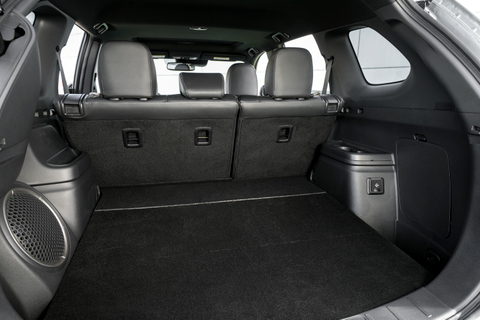
As popular as SUVs and hybrid are these days, it’s extremely surprising Mitsubishi is the only automaker to combine the two, while mixing in a plug-in feature and an affordable starting price. Its closest true competitor in the people-moving PHEV category is a minivan — the Chrysler Pacifica Hybrid. And for those who might not care about the plug-in aspect, Toyota has its Highlander Hybrid. Of course soon to arrive are the Ford Explorer Hybrid, Ford Escape PHEV and Volkswagen’s all-electric I.D.Crozz.
There’s also a good reason to take a hard look at the 2019 Mitsubishi Outlander PHEV beyond emission-free driving–gasoline prices. They are creeping up and expected to reach $4.00 per gallon this summer. That’s another incentive, so if you are in the market to buy a crossover, take an Outlander PHEV test drive.
Make sure to opt-in to the Clean Fleet Report newsletter (top right of page) to be notified of all new stories and vehicle reviews.
Related Stories You Might Enjoy—People-Moving Hybrids
Road Test: 2019 Chrysler Pacifica Hybrid
Road Test: 2018 Toyota Highlander Hybrid
Detroit Auto Show: 2020 Ford Explorer Goes Hybrid
News: Volkswagen Adds I.D. Cross to EV Lineup
Disclosure:
Clean Fleet Report is loaned free test vehicles from automakers to evaluate, typically for a week at a time. Our road tests are based on this one-week drive of a new vehicle. Because of this we don’t address issues such as long-term reliability or total cost of ownership. In addition, we are often invited to manufacturer events highlighting new vehicles or technology. As part of these events we may be offered free transportation, lodging or meals. We do our best to present our unvarnished evaluations of vehicles and news irrespective of these inducements.
Our focus is on vehicles that offer the best fuel economy in their class, which leads us to emphasize electric cars, plug-in hybrids, hybrids and diesels. We also feature those efficient gas-powered vehicles that are among the top mpg vehicles in their class. In addition, we aim to offer reviews and news on advanced technology and the alternative fuel vehicle market. We welcome any feedback from vehicle owners and are dedicated to providing a forum for alternative viewpoints. Please let us know your views at publisher@cleanfleetreport.com.

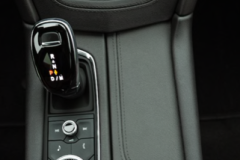
17 thoughts on “Road Test: 2019 Mitsubishi Outlander PHEV”